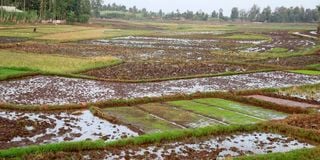Mwea rice and the power of co-ops

Preparations for rice plantation in Mwea, Kirinyaga County in this picture on July 19, 2022.
Rice has become a common fare in many homesteads, especially in urban areas, unlike in the past when it was only enjoyed during the festive season like Christmas.
Indeed, it has become the third most popular staple in the country after maize and wheat. In late December, out of curiosity engendered by passion, I visited the country’s largest rice-growing area in Kenya, Mwea in Kirinyaga County. It turned out to be a most edifying experience.
Now I know where the popular aromatic Basmati, Pishori and Sindano brands come from, and why some cheaper varieties turn into mush while cooking.
I also wanted proof that small farmers can, indeed, organise themselves and profit hugely by running their own cooperative societies with minimal government oversight. Mwea itself, approximately 100 kilometres from Nairobi by road, is a town running on the wheels of rice mills and co-operatives, as well as a disproportionate number of financial institutions.
Known locally as Wang’uru, it is one of the fastest-growing urban centres in Kenya. From a backwater settlement, this town has all the signs of becoming one of the most important agri-business hubs.
The vast panoramic rice paddies at its periphery are the major source of income for ordinary rice farmers, many of them the descendants of chaps who were locked up by the colonialists for Mau Mau activities at a detention camp nearby.
Apparently, many of these stalwarts so got used to working in the humid region, so they decided to stay on and grow rice.
Mzee Kenyatta’s government settled hundreds of families on the plain, allocating each four-acre piece of land. Their descendants are still farming there, although, of course, today they are using combine harvesters instead of sickles.
A more detailed look at the cooperative society is in order here, for it is a good example of what role such institutions can play in uplifting the living standards of their members.
Transformations
It has undergone a series of transformations since it was formed in 1964 as a thrift organisation that allowed farmers who had been licensed to grow their own rice.
Today, it is known as the Mwea Rice Growers Multipurpose Co-operative Society (MRGM) and has a financial arm known as Lainisha, whose specific function is to take in deposits and offer loans while at the same time taking care of farmers’ interests in the Mwea Rice Mills Ltd.
Multipurpose co-operative
On the other hand, the main purpose of the multipurpose co-operative is to help in the production, processing and marketing of rice, as well as training farmers. It also helps the growers in land preparation, providing seeds and inputs, transplanting the seedlings, and in organising the harvesting and transportation of the produce to the mill – all on credit.
This gives the rice growers an added incentive to care for their paddies, apply the correct inputs at the right time, and weeding all the time.
The commissioning of Thiba Dam in October last year was a true game-changer for the farmers because it now consistently supplies water for irrigation and will help widen the rice-growing area.
One of the greatest problems the growers faced in the past was how to irrigate the land with dwindling water resources, but now it may be possible to grow rice twice a year instead of just once.
Whoever came up with the idea of this dam was inspired. Kenya produces an average of 180,000 metric tons of rice per year, while the country consumes 950,000 metric tons, a deficit that can only be met through bulk importation, which need not be the case.
After all, this allows unscrupulous brokers to adulterate Mwea’s superior brands with inferior imports and pass them on as the original Mwea rice, thus ruining the reputation of the authentic brands. But that is not even the major problem.
Recently, the government allowed the duty-free import of 600,000 tons of rice to address food scarcity. Although the growers understood the need, they wanted such imports halted until all their stocks were exhausted. However, the government, quite correctly, would have none of it.
One of the major lessons I learnt during the excursion was that local farmers can satisfy the country’s food needs if they organise themselves in cooperatives run by professionals devoid of excessive government interference. The question is this: If the rice growers' cooperative society can succeed in raising the living standards of the local populations and contribute heavily to the country’s granary, why do we need huge multinationals that still dominate the country’s agricultural sector a full 60 years after independence?
Multinationals like James Finlay and Unilever are synonymous with tea, while Kakuzi and Delmonte dominate the avocado and pineapple markets respectively.
Between them, they own hundreds of thousands of acres, surrounded by thousands of poor Kenyans whose ancestors were dispossessed of land long ago, and who are now mere sources of cheap labour.
They own nothing, and are, in fact, squatters in the land. The fact that these multinationals are major taxpayers should not blind us to such injustice. As a first step, these folk should be allocated plots that they can call their own and where they can bury their dead.
Mr Ngwiri is a consultant editor; [email protected]





